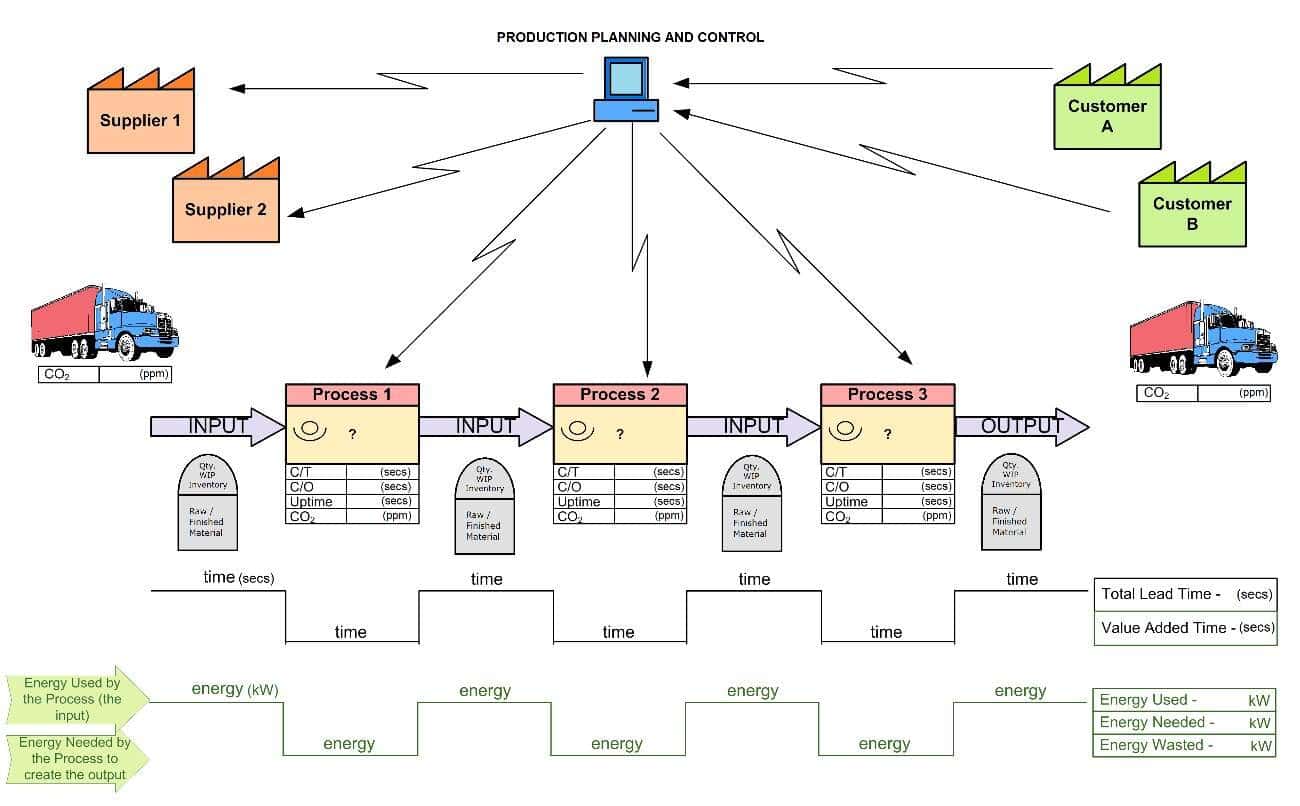A typical Value Stream Mapping (VSM) tool classifies the various industrial processes into value adding and non-value adding with a goal to identify and eliminate the non-value added (waste) activities. Based on the concept of Value-Stream Methodology, Energy Value-Stream mapping (EVSM) is being developed where energy components along with cost are added to evaluate with respect to time.
Energy Value-Stream mapping (EVSM) identifies the level of energy utilization and wastage in each step and hence determines the opportunities for energy conservations. Implementing this tool by incorporating electrical energy and fuel consumption provides with an ability to view the impact that process improvements have on reducing energy consumption and vice versa. Additionally, it can also deliver tangible and sustained results when used as a part of company’s improvement strategy and a structured analysis with a balanced set of data can reveal areas of energy improvements and optimization. In order to generate an even more sustainable Value-Stream, other environmental inputs in addition to energy like water usage and hazardous material usage can be mapped out to visualize the current process state. Moreover, the proposed model can also help as a guiding tool for energy budgeting and saving measures. A general layout of energy integrated into a Value-Stream Map shown below.

From the perspective of lean thinking, the energy consumption in a manufacturing process can be classified as value added, non-value added and waste. The objective of Energy Value-Stream Mapping (EVSM) is to evaluate and eliminate the waste energy, minimize the consumption of non-value added energy and to maximize the energy efficiency of value-adding activities, resulting in low production cost and less environmental impact. To achieve these goals, the answers to the following questions must be obtained and studied:
- Which processes consume the energy?
- How do the processes consume energy?
- How is the flow of energy within the factory?
- What is the actual energy requirement to manufacture a product?
- After assessing the current state Value-Stream and defining the future state Value-Stream, how can the future target condition be achieved?
These questions can help to monitor the energy consumption and evaluate the criticalities related to the non-value added activities and waste. The value added and non-value added energy is often confused with the direct and indirect energy consumption. In order to get a clear perspective of the types of energy consumed in a factory based on lean thinking, the three types of energy are evaluated and explained as follows:
- Value added energy: The energy that theoretically adds value to the product by transforming a material or semi-finished product into a more finished product. (E.g. energy consumed in drilling holes on a clutch plate, heat required in the quenching process of a steel component, etc.)
- Non value-added energy: Auxiliary energy which does not add direct value to the product, although mandatory to perform the process correctly. (E.g. Energy consumed by a motor to circulate coolant for turning operation.)
- Waste: Energy loss due to improper machine use, equipment failures, poor use of technology (E.g. Use of oversized press machines, poor furnace insulation, etc.)
The basic procedure for developing a Energy Value-Stream mapping (EVSM) includes mapping of all the process activities and other information which helps to visualize the current state and guides towards mapping the future desired state. These are the following steps to develop an Energy Value-Stream map for the sustainability strategy:
- Collect quantitative and qualitative data for energy usage, i.e. data on process parameters, temperature, power, compressed air etc.
- Using the collected data, construct the current state Energy Value-Stream map using relevant symbols.
- Using energy efficiency analysis, assess and evaluate the information of current state Value-Stream map with the aim to optimize energy consumption and eliminate the environmental waste.
- Construct and develop a future state Value-Stream map seeking solutions of energy consuming bottlenecks in various scenarios.
- Prepare an action plan to work towards the developed future state condition.